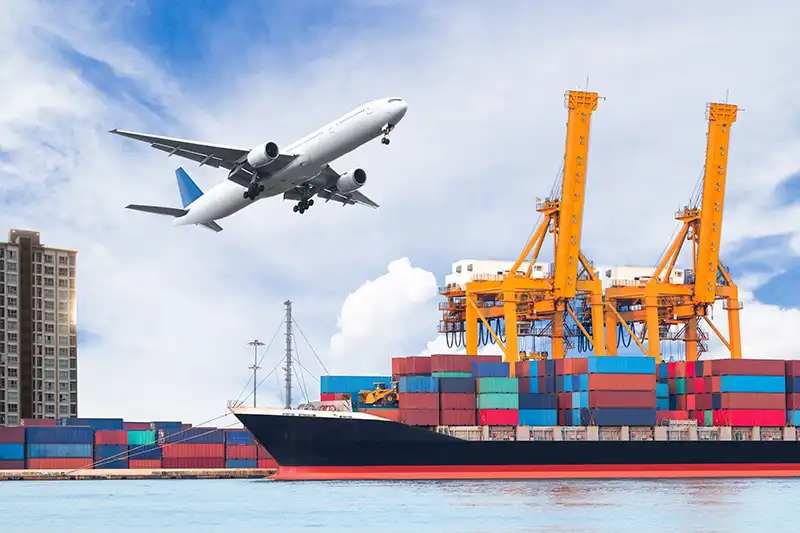In last week’s Entrepreneur Weekly, we looked at E-commerce: Covid Cure or Consumer Change and saw how small businesses are capitalising on this amalgamation of trade and technology. With a push for these businesses to tap into the export market, this week’s Entrepreneur Weekly explores options for e-commerce businesses to get their products to international customers. Two primary methods for international shipping stand out: air freight and sea freight. Each has its own set of advantages and drawbacks, making the choice between them a crucial decision.
Air Freight…What is it?
Simply put, air freight is the transportation of goods via aircraft. International air cargo is typically delivered using one of four methods – Passenger aircraft, Combi aircraft, Dedicated cargo-only planes and Supercargo planes.
Passenger aircrafts are primarily for as the name suggests, passengers. However, along with passenger luggage, the space is shared with cargo such as mail and postal packages. Similarly, combi aircrafts are passenger airliners that can convert some of their passenger compartments into cargo holds, increasing their freight storage capabilities.
On the other hand, a typical cargo-only plane does not have to divide its available space between cargo and passengers, and therefore has more capacity, while supercargo planes or super-transporters are generally intended for extra-heavy payloads.
Why Choose Air Freight?
The most attractive feature of this type of shipping is its speed. It’s much faster than shipping, rail or road transport. Airlines usually have strict departure and arrival times, with minimal delays, so the shipment of cargo by air is very likely to arrive on time adding to the reliability of air freight. The insurance premiums are also attractive, due to the short transportation time. Adding to these pros, the clearance time for air freight is fast, and there’s generally less stock to unload than that for cargo ships, so customs clearance is fast, and the need for local warehousing is much lower.
But…
Like any other mode of transport, air freight has its disadvantages. One, this service often comes at a higher cost compared to sea freight. The price is determined by the weight and volume of the cargo.
Another con is the impact of possible delays on the shipping time. Delays may result from weather conditions, incorrect or incomplete documentation, as well as changes in flight schedules. However, with air freight, there are restrictions with the types of items that can be shipped. Shipping Solutions says, “Some goods are too big or too heavy to be shipped in a plane…flammable, hazardous and other dangerous goods, including magnets, batteries and cellphones, have significant regulations around them, and while some are able to be shipped by air, some are not. Each airline has different policies about what they will and will not accept.”

Sea Freight – What is it?
Sea freight involves the transportation of goods in cargo containers aboard ships. The most common sea freight vessels are the Container Ships, Roll-On/Roll-Off (RORO) Ships, and Bulk Carriers.
Types of Sea Freight Services
Sea freight offers a variety of services to accommodate the diverse needs of businesses. Understanding these services can help you choose the most suitable option for your cargo.
- Full Container Load (FCL) involves the use of an entire shipping container exclusively for one shipper’s cargo. This option is ideal for businesses with substantial quantities of goods, ensuring that your products are not mixed with those of other shippers.
- Less than Container Load (LCL) is a cost-effective option for shippers who don’t have enough cargo to fill an entire shipping container. With LCL, multiple shippers share space within the same container, reducing cost.
- Roll-On/Roll-Off (RORO) vessels are designed for transporting vehicles, machinery, and other wheeled cargo.
- Bulk Carriers are specialised vessels designed to transport large quantities of bulk, unpackaged goods, such as grain, coal, ore, and minerals. These vessels are indispensable for industries dealing with raw materials in massive quantities.
- Tanker vessels are built for transporting liquid cargo, including crude oil, chemicals, and liquefied natural gas (LNG). Tankers play a crucial role in the global energy and chemical industries.
Why Choose Sea Freight?
Compared to other modes of shipping goods, sea freight is the most cost-effective option available to businesses looking to transport huge quantities of goods. Sea freight is about four to six times cheaper than air freight since tax duty, and Value-added Tax (VAT) for sea freight is cheaper than air.
A shipping vessel carries large quantities of goods in one shipment. Additionally, the containers holding cargos are well sealed for extra security, and trained crew members inspect the cargo regularly during transit. Therefore, ships can transport cargos safely.
Note too that shipping via sea has a low carbon footprint as they consume less fuel than other transportation modes, making it much more eco-friendly.
Weigh your options and determine the best type of freight to support your e-commerce business, as you go global.
But…
While it is known for its cost-effectiveness, especially for large shipments, it is generally slower compared to air freight. Unlike air freight, this mode of shipping takes up a lot of time. Since it takes a lot of time from shipping to delivery, the risks associated with sea freight are higher. So, if you are shipping valuables or smaller cargos, sea freight is not best for you. Additionally, insurance cost is typically higher than that of air freight.

JBDC Virtual Biz Zone
Want to learn more about shipping your products? Join the Jamaica Business Development Corporation’s Virtual Biz Zone webinar this Tuesday, September 12, 2023 at 10:00am. This session will be the first in the Logistics Series, zooming in on the topic ‘How the Right Shipping Strategy Can Grow your E-commerce Business’ presented by JBDC’s Inventory Officer, Haron Spencer.

Author









